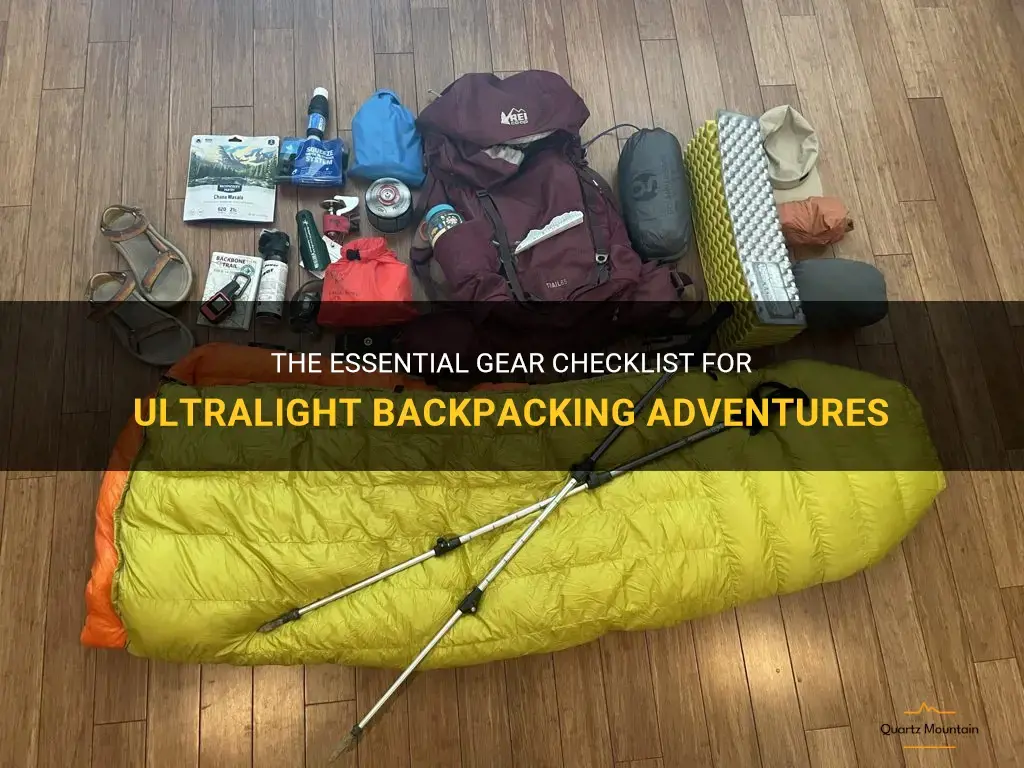
Have you ever dreamed of embarking on a backpacking adventure, immersing yourself in the beauty of nature and basking in the freedom of the open trail? If so, then ultralight backpacking might be the perfect pursuit for you. But before you hit the trails, it's crucial to ensure you have the essential gear to make your journey safe and enjoyable. From lightweight tents and compact sleeping bags to efficient cookware and sturdy hiking shoes, the gear checklist for ultralight backpacking adventures can make or break your experience. So, let's delve into the world of ultralight backpacking gear and discover the must-haves for your next outdoor adventure.
| Characteristics | Values |
|---|---|
| Weight | <10 lbs |
| Volume | <45 L |
| Durability | |
| Weatherproof | |
| Comfort | |
| Versatility | |
| Organizational | |
| Breathability | |
| Packed Size | |
| Cost | |
| Safety | |
| Sustainability |
What You'll Learn
- What are the essential items to pack for ultralight backpacking?
- How do I determine the appropriate weight and size for items when packing for ultralight backpacking?
- Are there any specific considerations for packing food and cooking utensils for ultralight backpacking?
- What types of clothing and footwear are recommended for ultralight backpacking?
- How do I ensure that I have adequate safety equipment and first aid supplies when packing for ultralight backpacking?

What are the essential items to pack for ultralight backpacking?
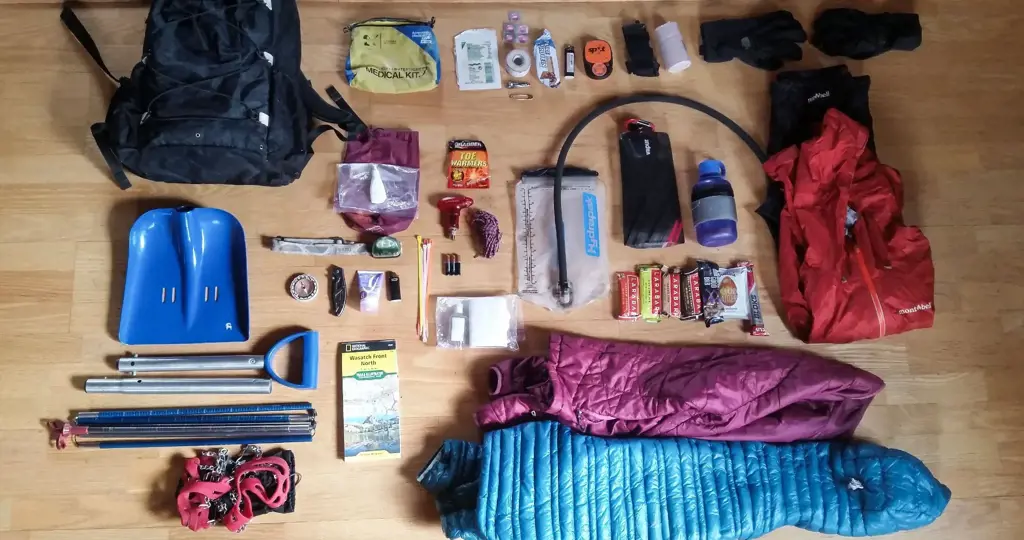
Ultralight backpacking has gained popularity among outdoor enthusiasts due to its emphasis on reducing pack weight and increasing mobility. When planning for an ultralight backpacking trip, knowing what items to pack is crucial. Here are some essential items to consider:
- Lightweight Shelter: A lightweight tent or hammock is a must for ultralight backpacking. Look for models that are compact, easy to set up, and made from durable materials. Tents with a single wall design or ultralight materials like Dyneema are great options.
- Sleeping System: Choose a lightweight sleeping bag or quilt that provides enough insulation for the expected temperatures. Consider a down sleeping bag, as it offers excellent warmth-to-weight ratio. Pair it with a lightweight sleeping pad for comfort and insulation from the ground.
- Cooking Gear: Opt for a lightweight stove and cookware. Alcohol stoves or canister stoves are popular choices for ultralight backpacking due to their low weight and simplicity. Look for cookware made from titanium or aluminum, which are lightweight and durable.
- Water Filtration: Water sources are essential during backpacking trips, but carrying large amounts of water can add significant weight. Invest in a lightweight water filtration system like a small water filter or chemical tablets to purify water on the go.
- Clothing: Pack lightweight and moisture-wicking base layers, such as merino wool or synthetic materials. Consider the expected weather conditions and pack a lightweight rain jacket and pants for protection against rain and wind. Bring a warm hat and gloves for colder temperatures.
- Multi-purpose Items: Look for gear that serves multiple purposes. For example, a lightweight knife can be used for food preparation, gear repairs, and even as a multitool. A bandana can serve as a towel, a headband, or a face mask.
- Navigation Tools: Always bring a detailed map, compass, and GPS device if needed. Familiarize yourself with the area's topography before the trip to ensure a safe and successful journey.
- Hygiene Essentials: Pack travel-sized toiletries like biodegradable soap, toothbrush, and toothpaste. Consider using lightweight products like a microfiber towel and hand sanitizer to minimize weight.
- First Aid Kit: Accidents can happen during outdoor adventures, so a basic first aid kit is essential. Include items like bandages, antiseptic wipes, painkillers, and any necessary personal medications.
- Food and Snacks: Plan your meals with lightweight and calorie-dense foods. Dehydrated meals, energy bars, nuts, and dried fruits are excellent options for ultralight backpacking trips. Avoid carrying excessive amounts of food to reduce weight.
Remember, the key to a successful ultralight backpacking trip is to prioritize necessities while minimizing weight. Practice packing and unpacking your gear to optimize space and organization. Consider the duration of your trip and the availability of resupply points when planning your supplies. With the right gear and preparation, ultralight backpacking can offer an incredible and liberating outdoor experience.
Essential Gear to Pack for Camping in Rainy Weather
You may want to see also

How do I determine the appropriate weight and size for items when packing for ultralight backpacking?
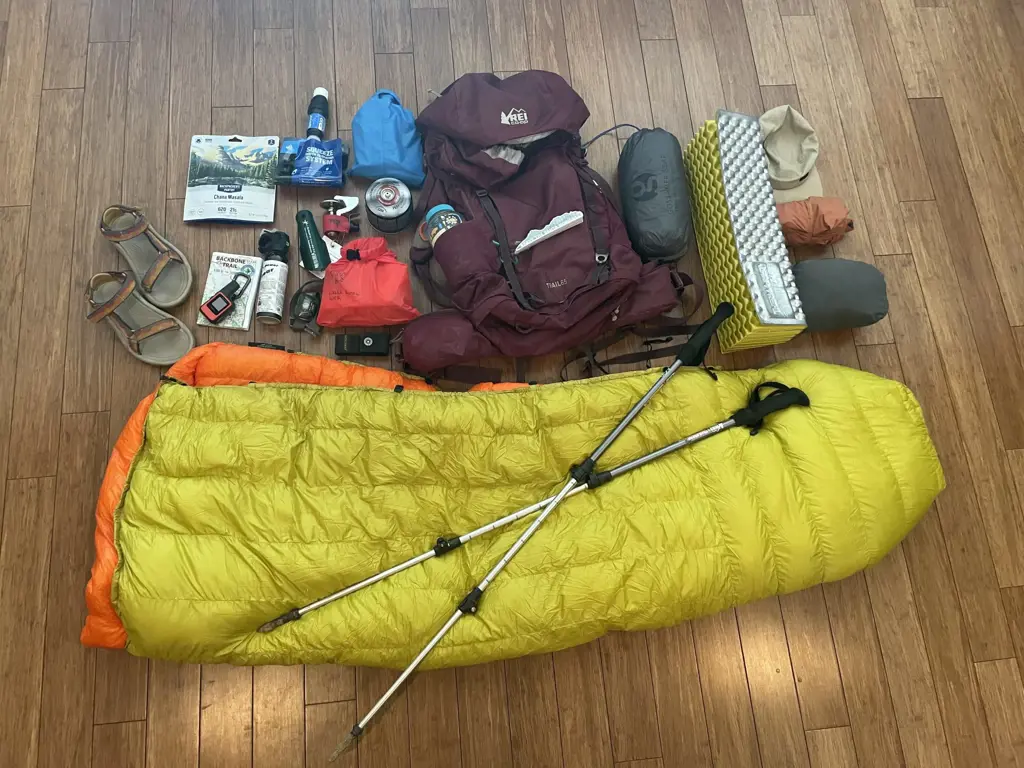
When it comes to ultralight backpacking, weight and size of items play a crucial role in determining how comfortable and manageable your trip will be. Carrying unnecessary weight can quickly drain your energy and impede your progress, while oversized items can take up valuable space and make packing a logistical challenge. Here are some steps to help you determine the appropriate weight and size for items when packing for ultralight backpacking.
- Assess your needs: The first step is to evaluate what items are essential for your trip. Consider the duration of your hike, anticipated weather conditions, terrain, and personal preferences. Make a list of the absolute necessities, such as shelter, sleep system (sleeping bag or quilt, sleeping pad), cooking equipment, clothing, and navigation tools.
- Research lightweight gear: Next, do thorough research on ultralight gear options available in the market. Look for items that are specifically designed for backpackers who prioritize weight reduction. Pay attention to the materials used, as some fabrics and components are lighter than others. Read reviews from other backpackers to gauge the durability and functionality of the gear.
- Weigh and measure your gear: Once you narrow down your gear choices, weigh and measure each item. Use a digital or portable scale to accurately determine their weight. Keep a record of the weight and size of each piece of gear to make comparisons and adjustments later.
- Consider multi-purpose items: Look for gear that serves multiple functions to save weight and space. For example, a lightweight quilt can function as a blanket during warm nights and a sleeping bag during cooler temperatures. Similarly, a trekking pole can double as a tent pole. Be creative in finding ways to reduce redundancies in your gear.
- Prioritize the "big three": The term "big three" refers to your shelter, sleep system, and backpack. These three items typically make up the bulk of your weight. Invest in a lightweight tent, tarp, hammock, or bivy that suits your needs and weighs as little as possible. Opt for a compact and lightweight sleeping bag or quilt, and choose a backpack that is designed for ultralight backpacking and has a comfortable fit.
- Practice the "leave no trace" principle: Ultralight backpacking is not just about minimizing weight; it is also about minimizing impact on the environment. Avoid packing unnecessary items that contribute to waste and litter. Choose eco-friendly products and learn how to properly dispose of waste while on the trail.
- Test your gear: Before embarking on a longer trip, take your gear for a test hike. This will help you identify any issues or shortcomings with your gear choices. Make adjustments as necessary, such as exchanging a heavy item for a lighter alternative or modifying your packing strategy.
- Pack strategically: Once you have determined the appropriate weight and size for each item, it's time to pack your backpack. Utilize techniques such as rolling clothes, compressing sleeping bags, and packing items in order of priority. Distribute weight evenly to improve balance and reduce strain on your back.
Remember, ultralight backpacking is a personal preference, and what works for one person may not work for another. It's essential to find a balance between weight reduction and comfort. Experiment with different gear options and packing strategies to find the combination that suits your needs best.
The Ultimate Guide to Packing for a Month-Long Vacation
You may want to see also

Are there any specific considerations for packing food and cooking utensils for ultralight backpacking?
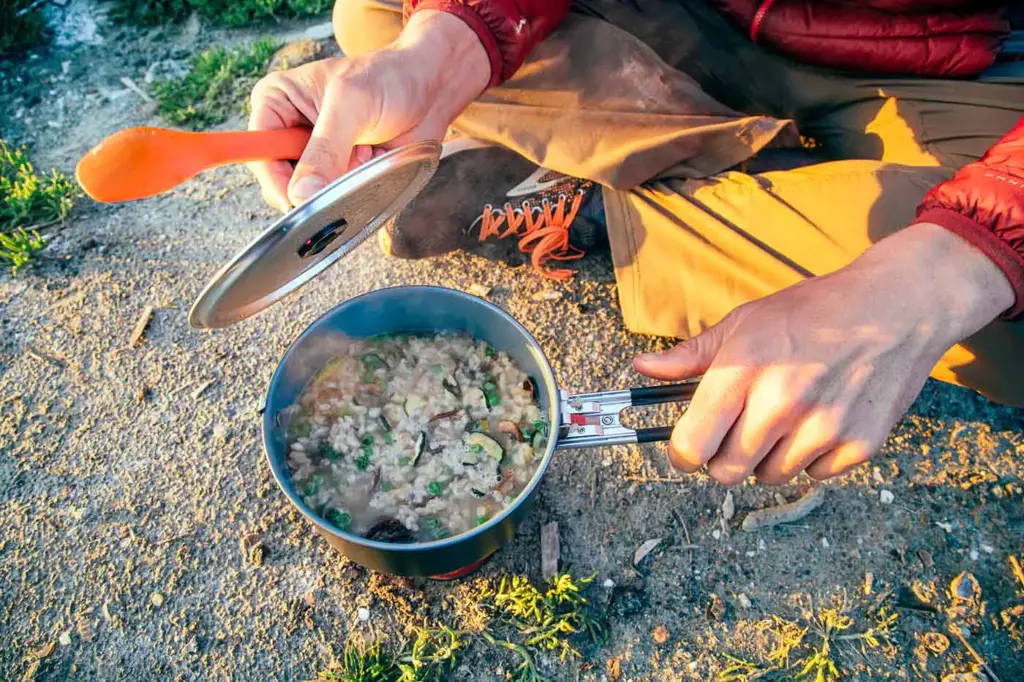
When it comes to ultralight backpacking, every ounce counts. Packing food and cooking utensils can add significant weight to your backpack, so it's important to make smart choices to keep your load as light as possible. Here are some specific considerations for packing food and cooking utensils for ultralight backpacking trips.
Consider the Weight and Nutritional Value of Foods:
- Look for lightweight, high-calorie foods. This includes dehydrated meals, trail mix, nuts, energy bars, and dried fruits.
- Opt for foods that are low in water content, as water adds unnecessary weight. For example, choose instant oats over regular oats and powdered milk over liquid milk.
- Prioritize nutrient-dense foods to fuel your body efficiently. This involves selecting foods that provide a good balance of carbohydrates, protein, and healthy fats.
Rethink Cooking Utensils:
- Evaluate the necessity of each cooking utensil. Can you do without certain items or find lighter alternatives?
- Invest in lightweight, compact cookware made from materials like titanium or aluminum. These materials are strong, durable, and have excellent heat distribution.
- Consider using a multifunctional cookware set, such as a pot with a detachable handle that can also serve as a mug or bowl. This eliminates the need to carry multiple items.
Pack Efficiently:
- Opt for lightweight and collapsible containers for storing food. This includes foldable food containers and lightweight freezer bags.
- Repackage food into smaller portions to reduce weight and save space. For example, transfer dehydrated meals into individual serving-size bags or use a vacuum sealer to remove excess air.
- Use your cooking utensils to store additional items. For instance, use your pot to hold your stove, fuel canister, or smaller cooking utensils.
Plan Meals and Snacks:
- Plan your meals in advance to ensure you have enough food and minimize waste. Consider calorie and nutrient requirements to avoid carrying excessive weight.
- Opt for no-cook or cold-soak meals on some days to eliminate the need for cooking utensils and save fuel.
- Choose snacks that are easy to eat on the go and require minimal preparation. This includes trail mix, energy bars, jerky, and dried fruits.
Practice Leave No Trace Principles:
- Dispose of food waste properly to avoid attracting wildlife. Pack out any leftover food particles or crumbs in sealed bags.
- Consider using a lightweight camping stove that leaves no trace, such as an alcohol stove. These stoves burn clean and have minimal impact on the environment.
- Use biodegradable soap to clean your cooking utensils and follow proper wastewater disposal guidelines.
In conclusion, packing food and cooking utensils for ultralight backpacking requires thoughtful consideration. Choosing lightweight, nutrient-dense foods and compact cookware can help reduce weight without sacrificing nutrition or convenience. By planning meals and snacks in advance, repackaging food, and packing efficiently, you can optimize your backpacking experience and make the most of your ultralight adventures.
Essential Items to Pack for a Memorable Trip to Santa Barbara
You may want to see also

What types of clothing and footwear are recommended for ultralight backpacking?
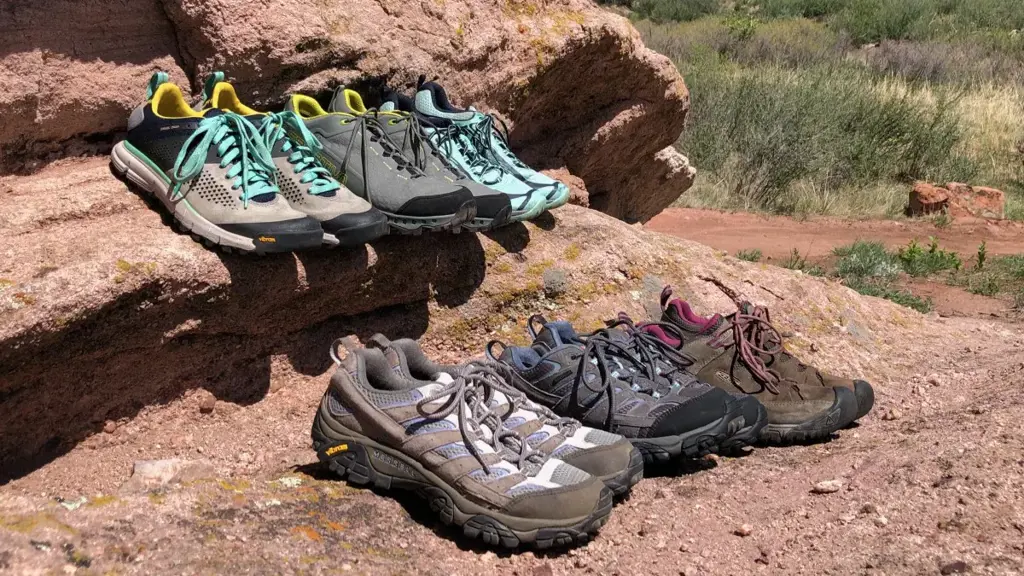
Ultralight backpacking has gained popularity among outdoor enthusiasts in recent years. By reducing the weight of your gear, you can enjoy a more comfortable and enjoyable backpacking experience. One area where weight reduction is particularly important is in your clothing and footwear choices. Here are some recommendations for the types of clothing and footwear that are ideal for ultralight backpacking.
Clothing:
- Baselayers: Choose lightweight and moisture-wicking baselayers made from merino wool or synthetic materials. These will keep you warm and dry without adding unnecessary weight to your pack. Avoid cotton as it retains moisture and can lead to discomfort and even hypothermia in cold temperatures.
- Insulating layers: Opt for lightweight down or synthetic insulation jackets that can be easily compressed and packed when not in use. These layers provide warmth and can be worn both during breaks and at camp.
- Shell layers: Invest in a lightweight rain jacket and pants made from waterproof and breathable materials. Look for jackets that have taped seams and ventilation options to prevent overheating. These garments will protect you from the elements while still being breathable and packable.
- Hiking shorts or convertible pants: Choose lightweight and quick-drying shorts or convertible pants that can easily be transformed into shorts. These will provide comfort and flexibility on the trail, especially in warmer weather.
- Socks: Wear lightweight and moisture-wicking socks that provide cushioning and prevent blisters. Consider bringing an extra pair to keep your feet dry during water crossings or at camp.
Footwear:
- Trail running shoes: Opt for lightweight and breathable trail running shoes with good traction. These shoes are designed for long-distance hiking and provide the necessary support and cushioning without adding unnecessary weight.
- Minimalist hiking boots: If you prefer more ankle support, consider minimalist hiking boots made from lightweight and flexible materials. These boots offer protection and stability while still being light enough for ultralight backpacking.
- Sandals or camp shoes: Pack a pair of lightweight sandals or camp shoes for relaxing at camp or for water crossings. These can be worn after a long day of hiking to let your feet breathe and recover.
- Gaiters: Consider wearing gaiters to prevent debris, rocks, and water from entering your shoes. Lightweight gaiters made from breathable materials can help keep your feet dry and protected.
When choosing clothing and footwear for ultralight backpacking, the focus should be on weight reduction without sacrificing functionality and comfort. Experiment with different combinations and materials to find what works best for you and the specific conditions of your backpacking trip. Remember to always test your gear and clothing choices before heading into the backcountry to ensure they meet your needs. By carefully selecting your clothing and footwear, you can enjoy a lighter and more enjoyable backpacking experience without compromising on safety and comfort.
Essential Items to Pack for a Winter Adventure in the Kalahari
You may want to see also

How do I ensure that I have adequate safety equipment and first aid supplies when packing for ultralight backpacking?
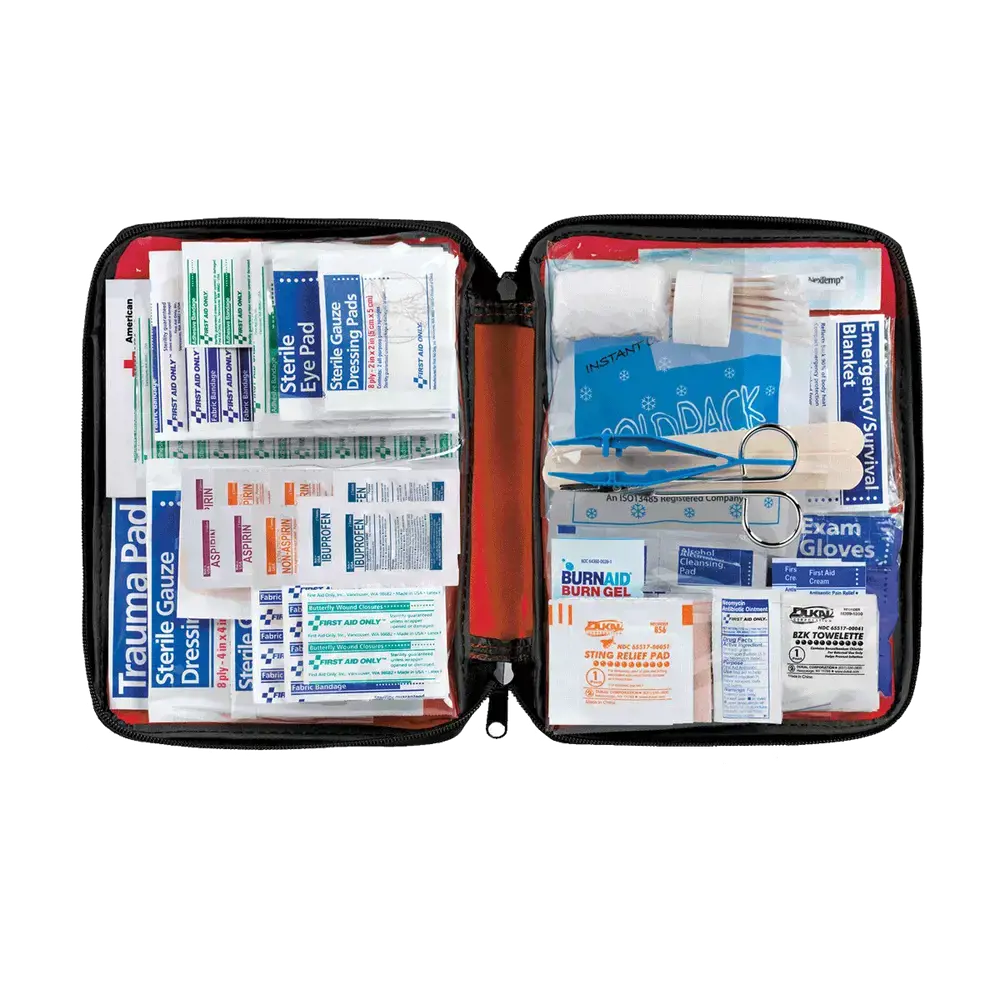
When embarking on an ultralight backpacking trip, it is important to prioritize your safety by packing adequate safety equipment and first aid supplies. While the ultralight philosophy encourages minimalism and reducing pack weight, it is essential to have the necessary items to handle potential emergencies and injuries. By following a few guidelines and considering your specific needs, you can ensure that you are well-prepared for any situation.
- Start with a thorough assessment: Before you even begin packing, evaluate the terrain, weather conditions, and length of your trip. This will help you determine the potential risks and the level of safety equipment and first aid supplies you will need. For example, if you are hiking in a remote area with unpredictable weather, you may need additional safety gear such as a satellite phone or GPS device.
- Pack a lightweight first aid kit: Invest in a compact, lightweight first aid kit that contains essential items such as band-aids, antiseptic wipes, gauze pads, adhesive tape, and pain relievers. It is also important to include any personal medications and allergy medications if needed. Consider your specific health needs and consult a medical professional if necessary.
- Customize your kit: In addition to the basics, tailor your first aid kit to your specific activities and potential injuries. For instance, if you're planning on water activities, include waterproof bandages and blister treatment supplies. If you're going rock climbing, pack a small splint or sam splint for potential fractures or sprains.
- Consider emergency communication: In case of an emergency, it is crucial to have a way to communicate with the outside world. Depending on the area you will be exploring, a satellite phone, personal locator beacon (PLB), or two-way radio might be necessary. Research the best communication device for your specific needs and ensure that it is easily accessible in your pack.
- Prioritize safety gear: While ultralight backpackers often try to minimize their gear, safety should not be compromised. Include essential safety gear such as a reliable headlamp, emergency whistle, compass, and emergency shelter such as a lightweight bivy or emergency blanket. These items can help you navigate in low visibility or seek shelter in case of unforeseen circumstances.
- Practice proper training and knowledge: Having the equipment is not enough; you must also know how to use it. Take the time to learn basic first aid skills, including CPR, treating wounds, and splinting fractures. Additionally, educate yourself on the local wildlife, poisonous plants, and potential hazards specific to the area you will be backpacking in.
- Regularly assess and update your equipment: Safety equipment and first aid supplies need to be regularly inspected and replenished. Before each trip, check the expiration dates of medications and replace any used or expired items in your first aid kit. Ensure that your safety gear is in good working condition, and if any items are damaged or outdated, replace them before heading out.
In conclusion, when packing for ultralight backpacking, it is essential to prioritize safety by including adequate safety equipment and first aid supplies. Take the time to assess your needs, customize your first aid kit, and pack essential safety gear. Stay knowledgeable about potential risks and train yourself in first aid techniques. By following these guidelines, you can enjoy your ultralight backpacking trip with peace of mind knowing that you are prepared for any situation.
Essential Items for a Successful Backpacking Trip
You may want to see also
Frequently asked questions
When packing for ultralight backpacking, it's important to prioritize lightweight and multi-purpose items. Some essential items to pack include a lightweight tent or shelter, a sleeping bag or sleeping pad, a lightweight stove and cookware, a water filter or purifier, a first aid kit, appropriate clothing for the weather conditions, a headlamp or flashlight, a map and compass, a multi-tool or knife, and food and water. It's important to consider the weight and size of each item and try to find the lightest options available to save on pack weight.
When it comes to clothing for ultralight backpacking, it's important to prioritize lightweight, moisture-wicking, and quick-drying materials. For a typical ultralight backpacking trip, you generally only need one set of clothing to hike in, one set of sleepwear, and one set of dry clothes to wear in camp. You can wear the same hiking clothes each day and wash them as needed. It's important to choose versatile clothing items that can be layered for different weather conditions and pack a lightweight rain jacket or shell for protection against rain and wind.
When packing food for ultralight backpacking, it's important to choose lightweight, high-calorie foods that are easy to prepare and don't require refrigeration. Some popular options include dehydrated meals, trail mix, energy bars, dried fruit, jerky, instant coffee or tea, and powdered drink mixes. It's important to calculate your daily calorie needs and pack enough food to sustain you for the duration of your trip. You can also consider repackaging food into lightweight, resealable bags or containers to save on pack weight.
There are several ways to reduce pack weight when ultralight backpacking. Some tips include choosing lightweight gear and equipment, packing only the essentials, eliminating unnecessary items, cutting down on packaging by repackaging food and toiletries into smaller containers, wearing your heaviest clothing and shoes while hiking, sharing gear with a hiking partner to distribute weight, and refining your packing list through experience and trial and error. It's also important to evaluate each item in your pack and ask yourself if it's necessary or if there is a lighter alternative.







